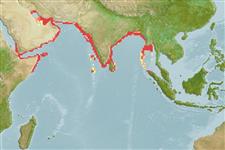Classification / Names
Common names from other countries
Main reference
Size / Weight / Age
Max length : 60.0 cm SL male/unsexed; (Ref. 188); common length : 36.0 cm SL male/unsexed; (Ref. 4832); common length :42 cm TL (female); max. published weight: 680.00 g (Ref. 4832); max. published weight: 680.00 g
Length at first maturity
Lm 41.5, range 34 - ? cm
Environment
Marine; freshwater; brackish; pelagic-neritic; anadromous (Ref. 51243); depth range ? - 200 m
Climate / Range
Tropical, preferred 27°C (Ref. 107945); 34°N - 5°N, 42°E - 97°E (Ref. 188)
Distribution
Indian Ocean: Persian Gulf eastward to Myanmar, including western and eastern coasts of India. Reported from the Gulf of Tonkin, Viet Nam (Ref. 9706). Reported in Tigris River basin and probably other rivers of southern Iran (Ref. 39702).
Countries | FAO areas | Ecosystems | Occurrences | Introductions
Short description
Dorsal
spines
(total): 0;
Dorsal
soft rays
(total): 18-21;
Anal
spines: 0;
Anal
soft rays: 18 - 23. Belly with 30 to 33 scutes. Distinct median notch in upper jaw. Gill rakers fine and numerous, about 100 to 250 on lower part of arch. Fins hyaline. A dark blotch behind gill opening, followed by a series of small spots along flank in juveniles. Color in life, silver shot with gold and purple.
IUCN Red List Status (Ref. 115185)
Threat to humans
Harmless
Human uses
Fisheries: minor commercial; aquaculture: experimental
More information
ReferencesAquacultureAquaculture profileStrainsGeneticsAllele frequenciesHeritabilityDiseasesProcessingMass conversion
Tools
Special reports
Download XML
Internet sources
Estimates of some properties based on models
Phylogenetic diversity index
PD50 = 0.5312 many relatives (e.g. carps) 0.5 - 2.0 few relatives (e.g. lungfishes)
Trophic Level
2.9 ±0.29 se; Based on food items.
Resilience
High, minimum population doubling time less than 15 months (K=0.5-1.2; Fec=220,000)
Vulnerability
Low to moderate vulnerability (31 of 100)
Price category
